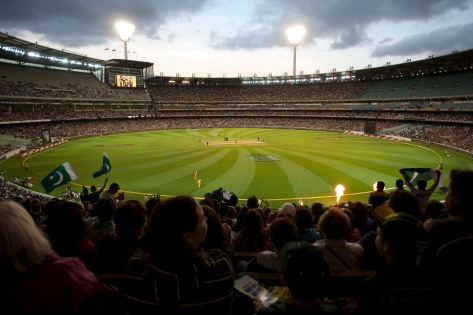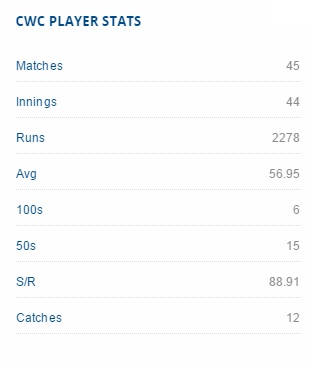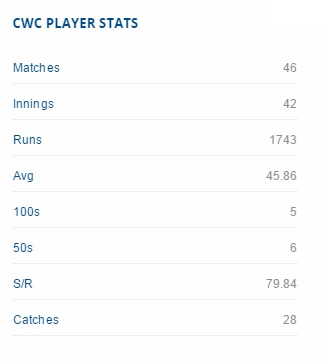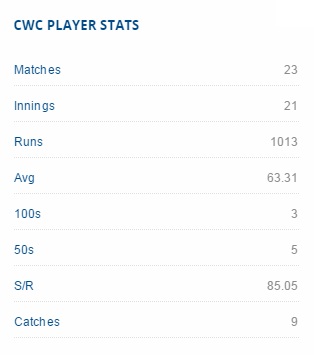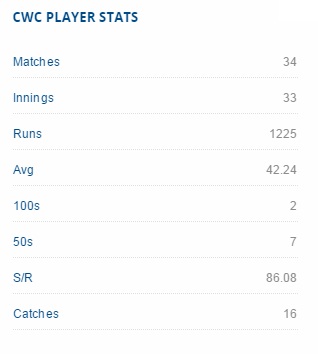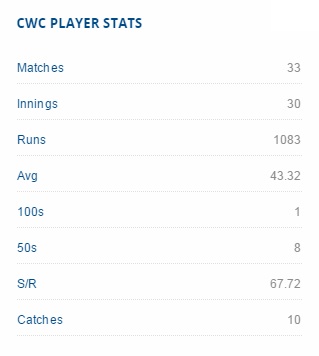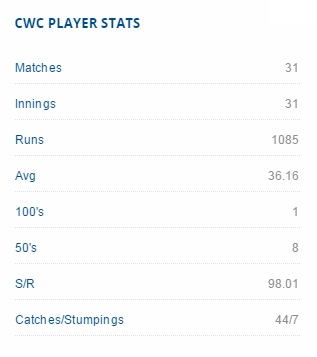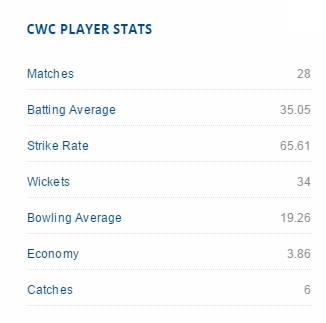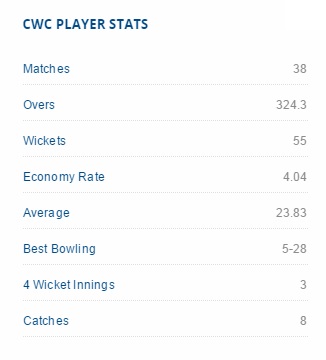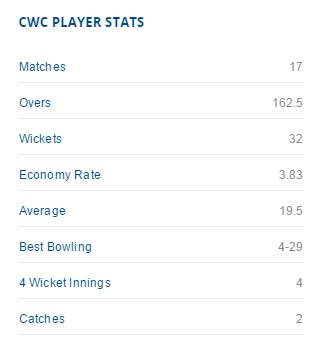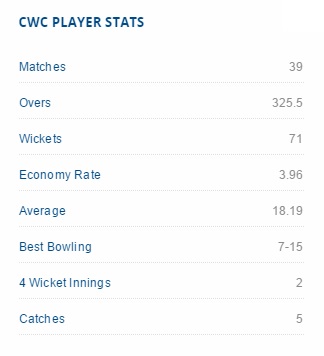10 Cricket World Cups in 15 countries…
19 Cricket Teams from 4 regions…
5 Winners at 7 venues…
The madness of cricket will reach its peak on Valentine’s Day when Sri Lanka will take on hosts New Zealand. The matches will begin at 4 different times which are 22:00, 1:00, 3:30 and 6:30 GMTs. Sadly for we Asians, we have to adjust our waking-sleeping times due to huge difference in timings.
This will be the second time that Cricket World Cup (CWC) will be hosted in the Oceanian region. The last time CWC was played here 22 years ago; color clothing, white cricket balls and black sight-screens were introduced. This was the beginning of modern-day cricket world cups organized on larger scale.
Since, 2857 ODIs have been played and the game of gentlemen has turned into game of entertainment. Once the game was a battle between batsman and bowler, but now the administration and lawmakers of cricket have moved the momentum by ruthlessly limiting restrictions on bowlers and gifting more favors to batsman so that the spectators and viewers can enjoy the runs and most specifically six-hitting festival.
The format of CWC always changes but this time as compared to the last edition, the format is same. Exactly 14 cricket teams will play 49 matches. Yesterday (21.12.14) I noticed on twitter, former Australian great Matthew Hayden picked his 11 greatest cricketers for any World Cup. That encouraged me to pick my XI and submitted on www.icc-cricket.com.
In this cricketing blog, I present you my Greatest CWC XI by batting order. My formation is 2 openers – 4 middies – 1 wicket keeper – 4 bowlers:
If New Zealand’s Mark Greatbatch was surely CWC’s first pinch-hitting opener back in 1992, then Sri Lanka’s Sanath Jayasuriya officially set the trend of big hitting and accelerating run-rate at the beginning of inning in 1996. His partnership in 1996 with another hitter Romesh Kaluwitharana became a stage of depression for all the bowlers as both accelerated the run rates from the start many a time. He was ‘Man of the Tournament’ of this edition.
Jaya is one of few CWC veterans who has played 5 or more editions. He played 38 matches, scored 1165 runs, picked 27 wickets and took 18 catches which easily make him one of CWC’s best all-rounder.
02. SACHIN TENDULKAR
Unarguably the greatest batsman along with Brian Lara the world has ever witnessed in this sport after Don Bradman, Gary Sobers and Viv Richards. His career stats speaks the greatness and service of an individual for the game and his runs make one realize how hungry he was, how sharp the blade of his bat was.
The little master and Javed Miandad are the only cricketers to serve their nation 6 times in CWC. The batting genius has most runs (2278), centuries (6), half-centuries (15) and fours (241) in CWC. Sachin was ‘Man of the Tournament’ for his 673 runs in 2003, which is also the most in any edition. He also is the only batsman who scored 4 consecutive 50s TWICE!!
03. RICKY PONTING (vice-captain)
46-matches-old CWC veteran! Punter was one of few who enjoyed 12-year CWC domination. Also he and Glenn McGrath were the only to play in 4 consecutive CWC Finals. He is only the 2nd captain in CWC after Clive Lloyd of West Indies to win 2 back-to-back or most titles. Without any doubt, both the captains led a very dominating cricket team in their times who ruled the world of cricket. He played a superb captain’s knock of 140* vs India in 2003 Final and got ‘Man of the Match’ award.
Ponting is 2nd to Sachin in CWC’S top runs scorer and centuries. He hit most sixes in CWC than any batsman (31). He also enjoys being CWC’s finest captain as per the stats as under his captaincy, Australia’s winning percentage was 92.85%. He led his side in 29 matches and won 26 of them. He lost 2 matches and faced a no-result all in last edition, when Australian domination was ended by new defending champions, India. Australia won every single game in 2003 and 2007 editions under him. As a fielder, he has the most catches (28) by a non wicket-keeper and most in a singe edition (11) i.e., in 2003.
04. VIV RICHARDS
Sachin and Lara surely were the greatest batsmen of their time but will never reach the height where Viv Richards truly was. Richards was one true ambassador of the game in those times when the corporate and big-money pocketers put heavy investment in the game and brought the soul of limited overs cricket. He was a smasher with bat and faced one of most remarkable fast bowlers of his time as compared to Sachin/Lara, that one argument where King of cricket unanimously wins.
Viv was the first batsman to reach 1000 runs in CWC. Among all 13 batsmen of 1000-runs scoring club, he enjoys the best average (63.31). His 138* in Final of 1979 edition will be remembered as one of the greatest WC knocks the batsman has ever played, for which he was also awarded ‘Man of the Match’.
05. BRIAN LARA
Cricket’s most charming strokes-player ever and one of most stylish batsman ever to grace modern-day cricket. One cannot ignore him in any batting list and I will mention his name in my XI.
Lara is veteran of 5 CWCs and third-highest runs scorer in tournament’s history after Tendulkar and Ponting. He scored 2 CWC 100s and both were against South Africa, and both were fabulous knocks. Lara played his last CWC at home in 2007 unfortunately his team wasn’t that strong enough to make a history and retired with 299 ODIs.
06. JAVED MIANDAD
Calm but lively character, Miandad was the name who stayed more in the contest in most critical situations, who occupied the crease to frustrate any bowling line-up. Miandad was the first to participate in 6 CWCs, the other being Tendulkar as mentioned before. He was 2nd to Viv who reached 1000 CWC runs.
Among all 13 batsmen of 1000-runs scoring club, Miandad had the least no. of boundaries hitting only 72 fours and 3 sixes which shows his untiring efforts and laboring mountain of runs between the wickets. For a huge surprise, Miandad wasn’t selected for Pakistan squad of 1992 edition. But he returned to squad in practice matches and the rest is history.
07. ADAM GILCHRIST
Only a fool will omit his name in this specific XI when it comes in picking a wicket-keeper. Gilly was one of the most destructive batsmen ever played CWC. He played 3 CWCs and won all. His last CWC knock was ‘Man of the Match’ winning monumental 149 in the Final of 2007 edition against Sri Lanka.
As wicket-keeper, he lead the list of most dismissals (52) in CWC which includes 45 catches (also a record) and 7 stumpings. Gilly is the only wicket-keeper/batsman with 1000 CWC runs. Also to his name is most dismissals (21) in single edition and also in one match (6) both achieved in 2003.
08. IMRAN KHAN (captain)
A leader whose leadership inspired his team to attempt a miracle and took the 1992 title in front of 87,000 world record attendance of Melbourne Cricket Ground against tournament favorites England. Imran Khan was known for his leadership skills and famously termed his team ‘Cornered Tigers’ when Pakistan heavily needed a major morale boosting comeback. Imran was veteran of 5 CWCs, who led his team in CWC thrice. Pakistan played 22 matches under him, won 14 of them with win percentage of 63%.
Once, Imran was leading wicket-taker in CWC with 34 wickets out of which half were grabbed in 1987 edition. He averaged 19.86 in bowling, which is 2nd best after Glenn McGrath in CWC. He definitely is my captain for this CWC XI with Punter his deputy.
09. WASIM AKRAM
One of the greatest left-arm bowler cricket has ever produced. Wasim Akram known as ‘Sultan of Swing’ was the first bowler to reach 50 wickets in CWC and is 3rd among leading wicket takers in CWC (55). He played 38 matches, which is the most by any Pakistani, 15 of them he captained the side.
Wasim’s most unforgettable performance to date is his heroic all-round performance in 1992 CWC final. Those two game changing deliveries to Allan Lamb and Chris Lewis in the final will be remembered for long time and was awarded ‘Man of the Match’. He led his side to the final of 1999 where most of his boys in the squad played their first CWC unfortunately losing to Steve Waugh‘s Australia from where their rule on cricket began.
10. SHANE WARNE
This might be debatable like a never-ending argument to speak if Warne was better or Murali. Same goes here in CWC. Despite the fact Murali had 68 wickets, I will go with Warne’s 32. He played 2 CWCs and the biggest impact on stage was his back-to-back 4 wicket-hauls in 1999 edition which gifted his side to take the title for the first time in 12 years. Warne was awarded ‘Man of the Match’ in both Semifinal and Final.
Shane along with Geoff Allott became leading wicket taker in any edition with 20 wickets. He has grabbed 4-wicket hauls in CWC four times (along with Murali), which is the most by any.
11. GLENN MCGRATH
And my last pick is going to be one of the most deadliest line-and-length fast bowler, Glenn McGrath. He is the leading wicket-taker in CWC with 71 wickets. Also tops the list of best bowling figures of 7/15 vs Namibia in 2003. His CWC bowling average of 18.19 is also above all names and in bowling strike rates (27.5), he is just 2nd to Zaheer Khan.
Glenn played 4 CWCs and reached all the Finals. He along with Ponting and Gilchrist are the only cricketers to play 3 successive CWC finals. 2007 was his last and made another record with most wickets by any bowler in single edition with 26. For this extraordinary performance, he was chosen ‘Man of the Tournament’.
Picking XI for any certain criteria is never easy. Selecting 11 greatest cricketers of CWC history always need a thorough research and achievements by individual. Brian Lara is the only player in my XI who never won the CWC. I believe my biggest omission is Muralitharan who grabbed 68 wickets in 5 CWCs. Sachin, Wasim and Gilly were the most obvious choice. Arrangement of batting order was a problem as Javed usually batted at #4 and Lara played most part of his ODI career at #3 and #4. Gilly who batted most of his career as opener is compromised at keeper’s best slot #7 for the sake of Jayasuriya.
Apply ICC field restrictions new or old, my openers Jaya/Sachin will always be delight to watch together. These two ODI veterans are the only cricketers who have served their teams for more than 20 years this century. Either you bowl first or later, either you have new ball or old, my opening bowlers Wasim-McGrath will be the most ideal and deadly combo on any surface. Captain Imran Khan will be my ideal first change with Warne’s varieties of leg-spinning from the other hand.
With 4 powerful bowlers, I will use Jaya and Richards. Both were slow-arm orthodox but very very handy for their teams. Jaya had 323 ODI wickets and his bowling famously turned the Semifinal match against India in 1996 edition which ended in Sri Lanka’s favor due to crowd’ disturbance. Richards had 118 ODI wickets and his 3/52 in Semifinal match against Pakistan in 1979 assured West Indies path to Final. Still need more hands in bowling, Sachin could bowl many varieties besides fast bowling and had 154 ODI wickets to his name.
I don’t think this team needs a head coach for any CWC, but if asked then I will pick John Buchanan because Bob Woolmer is no more. Hope the readers found the blog and my Greatest CWC XI interesting. You may share your feedback below.
To view my team, click here.
To make your own Greatest CWC XI, click here.
May the best and most deserving team takes the glory at MCG…
Follow me on twitter @saminaik_asn
